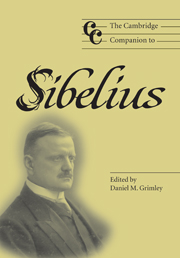Book contents
- Frontmatter
- Introduction
- Part I Forging a voice: perspectives on Sibelius's biography
- Part II Musical works
- Part III Influence and reception
- Part IV Interpreting Sibelius
- 14 Different kinds of fidelity: interpreting Sibelius on record
- 15 Performing Sibelius
- Notes
- Select bibliography
- Index of names and works
14 - Different kinds of fidelity: interpreting Sibelius on record
from Part IV - Interpreting Sibelius
Published online by Cambridge University Press: 28 September 2011
- Frontmatter
- Introduction
- Part I Forging a voice: perspectives on Sibelius's biography
- Part II Musical works
- Part III Influence and reception
- Part IV Interpreting Sibelius
- 14 Different kinds of fidelity: interpreting Sibelius on record
- 15 Performing Sibelius
- Notes
- Select bibliography
- Index of names and works
Summary
Recording Sibelius
‘Few composers have benefited as much from the invention of the phonograph as has Sibelius,’ claimed Harold Johnson in 1959. Appreciating the role of recording technology in shaping our view of Sibelius's music is vital, whether we are studying his historical importance or his musical style. There is useful information to be extracted from any part of the recording tradition we choose to examine: the emergence of the earliest recordings, the flourishing of different performing styles, and his continued popularity on record today each tell a story.
With the wealth of recorded material available on CD and other accurate, easily accessible formats at the beginning of the twenty-first century, it is hard to imagine how different life must have been for a music student, enthusiast, or scholar before the advent of musical recording. Favourite pieces, standard repertoire, and new works could be encountered only through close study of the score, by playing them oneself (in piano solo or piano duet versions for orchestral or other large works), or in occasional, treasured performances. The study of complex, large-scale, or musically innovative works was greatly facilitated once listeners could obtain a reliable way of hearing them repeatedly. The major wave of popularity for Sibelius in the 1930s was caused by many factors, including a political and aesthetic resistance to the German avant-garde and a desire for symphonic works as a comprehensible alternative; however, another significant factor was the new process of electrical recording which allowed relatively faithful reproduction of the complex sounds of a symphony orchestra.
- Type
- Chapter
- Information
- The Cambridge Companion to Sibelius , pp. 217 - 228Publisher: Cambridge University PressPrint publication year: 2004

